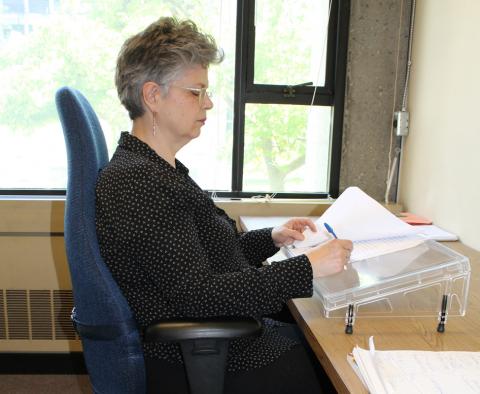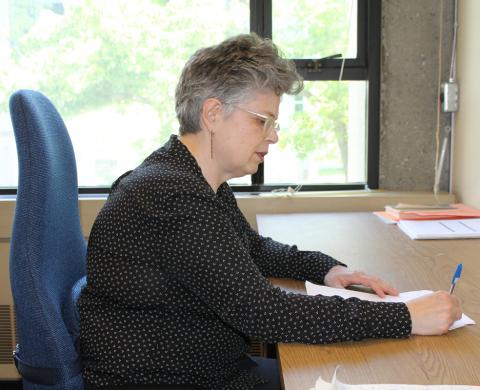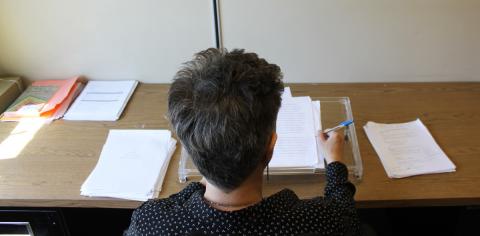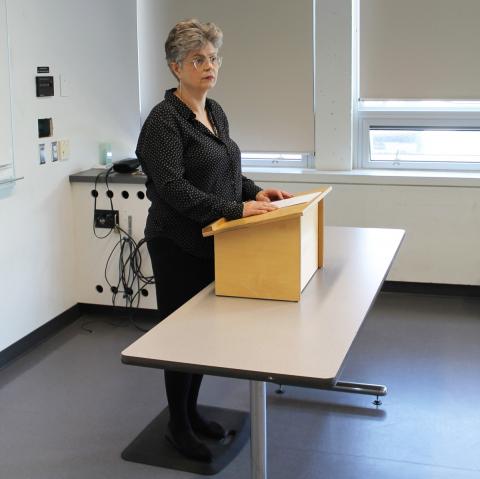Faculty, instructors and teaching assistants (TAs) can spend hours marking and lecturing over the course of a semester. The static positions and awkward postures associated with these tasks can result in musculoskeletal injury risks (e.g. upper back, shoulder and neck tension when marking; or foot, knee and back discomfort when standing to teach).
The following recommendations for marking and lecturing can help minimize discomfort and improve productivity. The UBC Ergonomics Program is continuing to work with learning spaces and faculty to develop additional recommendations; we will provide more information as it becomes available.
Marking
As a professor, instructor or teaching assistant, you can spend hours in awkward postures while marking. Taking micro-breaks and setting up your workstation to support neutral working postures can reduce the risk of discomfort and injury.
Ideal positioning

Tips:
- Use an office chair that has a backrest and adjustable seat height and seat pan options. You should also find the chair comfortable.
- Adjust the chair height so that the paperwork is approximately elbow level. Place a footrest under your feet if they are not fully supported by the floor.
- Sit all the way back in the chair and allow the backrest to support your back.
- Shoulders should be relaxed and elbows close to the body while marking.
- Position yourself close to the desk to avoid leaning forward and reaching.
- A sloped document riser is recommended to reduce neck and thoracic flexion.
- Incorporate 1-2 minutes of stretching or micro-breaks every hour to provide position change and visual rest.
Improper positioning
Image
Risks:
- Neck flexion (looking down at paperwork) increases strain on the neck and shoulder musculature
- Shoulder flexion (reaching forward) increases load on neck and shoulder musculature
- Upper-back flexion (leaning forward) increases strain on shoulder and back musculature
Workstation layout

Tips:
- While marking, organize your paperwork in a sequential manner and make it easy to reach.
- Reduce clutter and avoid placing distracting objects around the marking station.
By establishing the following workstation reaching zones, you can reduce the occurrence of reaching and awkward postures:
- Primary zone: Frequent reaches to the keyboard/mouse and written work being marked should be kept within 36 cm/14.2″ of you.
- Secondary zone: Infrequent reaches of items such as telephone, drinking cup, eraser or notebook should be kept within 50 cm/19.7″ of you.
- Tertiary zone: Occasional reaches to seldom-used items such as textbooks or binders can be stored outside of the 50 cm range. If you need to reach for these items, try standing up to get as close as possible instead of bending forward from a seated position.
How you organize your workstation can contribute to improved productivity and mental wellbeing as much as your physical wellbeing. Arrange your workstation in a manner that works for you and allows you to separate marked and unmarked assignments.
Laptop work
For more information, visit the Ergo Your Office Guide on Mobile Computing.
Lecturing
Lecturing may require professors to stand for up to three hours at a time. There is widespread knowledge regarding the negative health effects of static sitting; however, there is also evidence that static standing can lead to undesirable consequences such as low-back and knee pain, and varicose veins. Good standing posture is important to prevent discomfort, but it alone is not enough. You should also incorporate positional change, such as intermittent walking or sitting throughout the lecture.

Tips:
- Move and make positional changes before discomfort sets in, or aim to adjust your position at least every hour.
- An anti-fatigue mat can be helpful if you experience lower-limb and back pain.
- Consider using a stool to sit intermittently while lecturing.
- Wear appropriate footwear.
- Walk periodically instead of standing in one place.
- Encourage students to take a stretch breaks every 50 minutes to give both you and the students a chance to make a positional change.
Breaks, pacing and positional Change
Look for opportunities to incorporate positional change in your workday and make an effort to take a micro-break (30 seconds to 2 minutes) at least every hour, preferably every 30 minutes.
The body’s soft tissues require rest in order to recuperate from the effects of the static postures we exhibit. Prolonged standing can lead to negative effects such as low-back, knee and lower leg discomfort, and varicose veins.
Consider changing between sitting and standing while lecturing , or incorporate walking if sitting is not practical. Use hourly breaks as opportunities for positional change by sitting to answer students’ questions or lead a classroom stretch session.
Be aware of your body’s warning signs of discomfort. Ideally, you should stop and take a break before discomfort sets in. Micro-breaks will allow your body’s tissue tolerance to recover near baseline and allow you to maintain productivity over longer periods of time spent working.